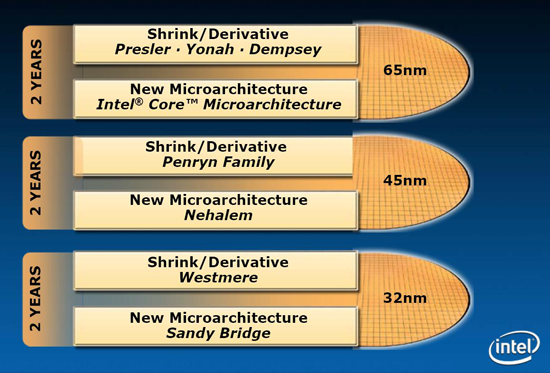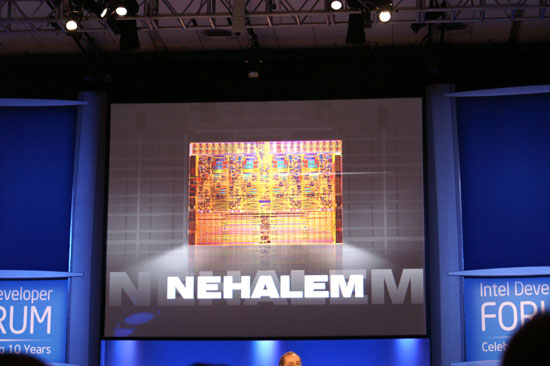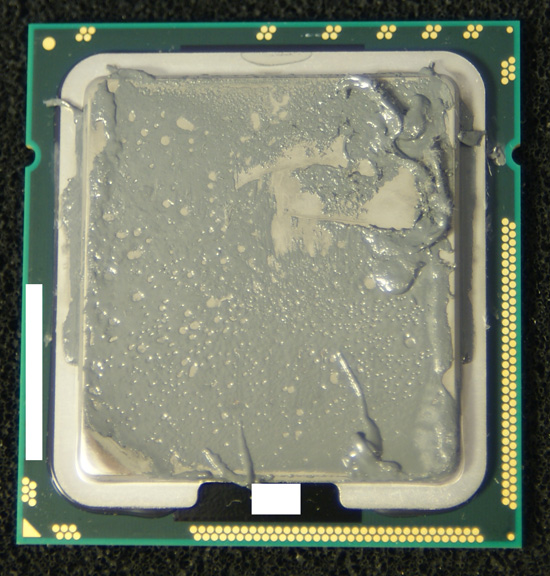The Nehalem Preview: Intel Does It Again
by Anand Lal Shimpi on June 5, 2008 12:05 AM EST- Posted in
- CPUs
Two years ago in Taiwan at Computex 2006 Gary Key and I stayed up all night benchmarking the Core 2 Extreme X6800, the first Core micro-architecture (Conroe core) CPU we had laid our hands on. While Intel retroactively applied its tick-tock model to previous CPU generations, it was the Core micro-architecture and the Core 2 Duo in particular that kicked it all off.
At the end of last year we saw the first update to Core, the first post-Conroe "tick" if you will: Penryn. Penryn proved to be a nice upgrade to Conroe, reducing power consumption even further and giving a slight boost to performance. What Penryn didn't do however was shake the world the way Conroe did upon its launch in 2006.

After every tick however, comes a tock. While Penryn was a die shrink of an existing architecture, Nehalem is a brand new architecture built on the same 45nm process as Penryn. It's sort of a big deal, being the first tock after the incredibly successful Core 2 launch.

731M transistors, four cores, eight threads
It's like clockwork with Intel; around six months before the release of a new processor, it's sent over to Intel's partners so they may begin developing motherboards for the chip. It was true with Northwood, Prescott, Conroe, Penryn and now Nehalem. And plus, did you really expect, on the eve of the two year anniversary of our first Core 2 preview, a trip to Taiwan for Computex without benchmarks of Nehalem? In the words of Balki Bartokomous, don't be ridiculous :)

Yep, that's what you think it is
Without Intel's approval, supervision, blessing or even desire - we went ahead and snagged us a Nehalem (actually, two) and spent some time with them.
(Sorry guys, stop making interesting chips and we'll stop trying to get an early look at them :)...)










108 Comments
View All Comments
weihlmus - Friday, September 5, 2008 - link
is it just me or does lga1366 bear more than apassing resemblance to amd's logo...if only they could have crammed it into 1337 pins - "nehalem - the 1337 chip"
Proteusza - Friday, July 11, 2008 - link
I see that on the Daily Tech main page, the headline for this article now reads:"June 5, 2008
Post date on AnandTech's Nehalem preview, before it was ripped and republished on Tom's Hardware"
Does anyone know what happened? I cant find the same article on Tomshardware, I presume they took it down.
xsilver - Friday, June 20, 2008 - link
10 pages of comments and not one about the future of overclocking?No more FSB = no more overclocking??????
Enthusiasts might jump ship if overclocking usually brings 20% extra performance, all amd have to do is come within 10% on performance and below on price?
Akabeth - Thursday, June 19, 2008 - link
JebuzzzThis pretty much makes it pointless to purchase any high tier mobo and quad core today... It will be eclipsed in 6 months time...
Some of the numbers here make me wonder, "Are you f*cking kidding me?"
JumpingJack - Friday, June 13, 2008 - link
Anand, you could clear up some confusion if you could specify the version of windows you ran. The screen shots of some of your benchmarks show 64-bit Vista, yet your scores are inline with 32-bit Vista.... it makes a difference.JumpingJack - Friday, June 13, 2008 - link
Nevermind, page 2 shows 32-bit Vista... makes sense now. You should becareful when posting stock photos, the Cinbench reflects 64-bit.barnierubble - Sunday, June 8, 2008 - link
It appears to me that the Tick Tock cycle diagram is wrong.Conroe shooked the world in the second half of 2006, Penryn came in the second half of 2007, now 2008 we have Nehalem on the horizon set for the second half of this year.
Now that is 2 years between new architectures with the intermediate year bringing a shrink derivative.
That is not what the diagram shows; bracketing shrink derivative and new architecture in a 2 year cycle is clearly not fitting the reality.
mbf - Saturday, June 7, 2008 - link
Will the new IMC support ECC RAM? And if so, what are the odds the consumer versions will too? I've had a bit of bad luck with memory errors in the past. Since then I swear by ECC memory, even though it costs me a bit of performance. :)Natima - Saturday, June 7, 2008 - link
I just thought I'd point out that the Bloomfield chip reviewed (to be released in H2 2008) will infact dominate the gamer/high-end market.http://en.wikipedia.org/wiki/Nehalem_(microarchite...">http://en.wikipedia.org/wiki/Nehalem_(microarchite...
The smaller sockets will be for what I like to call... "office PC's".
And the larger socket for high-end servers.
A majority of custom PC builders will be able to buy & use Nehalems by the end of the year. Hoorah!
Natima - Saturday, June 7, 2008 - link
The article semi-implied that chips for the PC enthusiast would not be out until mid-2009. Just wanted to clarify this for people.